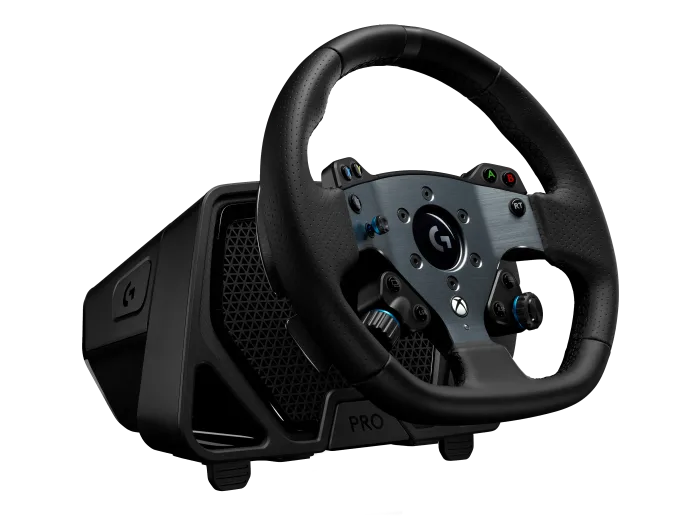Before I begin, I should mention I am not sponsored by Logitech or have any affiliation with them. I also wanted to make note that I do not have this wheel on site and this review dives into the tech details and offers firsthand knowledge of past experiences with Logitech and Fanatec. Now, without further adu, I present the Logitech Pro Racing Wheel. It looks awesome!
It’s not often that I get to make updates introducing noteworthy gear. Recently it was announced that there is a new direct drive wheel from Logitech. This is big news because, until recently, direct drive wheels have been dominated by Fanatec and SimCube. There is a catch that we will get to, but in general this seems like a solid wheel for sim racing enthusiasts. So let’s get down to business!
The Price
Let’s start with one of the most important things, the budget. This is not a cheap wheel. The Pro Racing Wheel comes with a wheel base and the rim. The wheel debuted at $999 USD. If you are a previous or current Logitech wheel owner, this price will come as surprisingly high. In the grand scheme direct drive wheels, it’s average. It is important to note that this wheel does not come with pedals. The pedals are sold separately, which will also comes as a surprise to Logitech fans. If the wheel is expensive, is it worth it? It is a direct drive wheel, so, yes it can be.
One disadvantage is that for $500 USD you can get a direct drive wheel from Fanatec, in the way of the CSL DD. The difference is that the CSL DD is 8 newtons of force and Logitech peaks at 11nm. If you want the pedals, that will net you another $350 USD in hardware. This is still reasonable as Fanatec and SimCube offer pedals ranging from $300-$800 USD.
The Performance
We just discussed how the Logitech Pro Racing Wheel peaks at 11nm, but is that good? In short, yes. 11nm is well within a range to produce realistic driving conditions. However, the competitors of Logitech, Fanatec and SimCube, produce wheels that can peak from 15-20nm. What does higher force even do? Ultimately, the higher numbers are able to replicate conditions without clipping. A recent survey through several sim racing forums, revealed a lot of drivers run between 8-10nm of force. Those with higher output wheels were setting their outputs to half. Any unused force is utilized to prevent clipping. Clipping is when there is lack of detail or no resistance because the input exceeds the capability of the motor. At 11nm, it is unlikely that you would experience clipping, beyond hardware failure. So far, so good!
Durability/Ease of Use
The first thing I wanted to cover here is the mounting system. Logitech claims to have an easy to use clamping system. The problem is that the DD wheel puts out enough force to overcome the usefulness of said clamp. Luckily, the wheel comes with standard mounting holes. You can also download the drilling template to add your own mounting solutions. According to the few reviews online, there were no durability issues to be found. One downside is that there are no spare parts listed on Logitech’s website. If something on the wheel breaks, there doesn’t seem to be a way to replace said part. Competitors Fanatec and SimCube offer replace parts for customizations and self-service repair.
In-Game
Lastly, let’s talk about in-game experience. I think this is where there is a lack of data currently. In general, it should be noted that Logitech has a track record of being compatible with many racing titles. However, it should be noted that TrueForce has not been widely accepted in the racing community. This means that you may have a less than desirable experience on non-mainstream games. This wheel, and those like like, would likely benefit more for iRacing and ACC users, as these games tend to support the more niche features, such as TrueForce.
Aside from the software technology, there are some features that really standout, in a good way. The first is the dual-clutch setup. The paddles offer a dual-clutch feel, which is something you can only buy from Fanatec as an additional $200 part. This feature will allow open-wheel racers a bit more realism with shifting. It can also provide a very unique feel when shifting. The second is the button layout. Logitech did put some thought into the button layout and did include a built-in rotary encoder. Both features offer a lot of value in sim racing. Don’t forget that we covered other valuable things to enhance sim racing immersion here.
TLDR
If you are looking for a TLDR, here it is. Logitech produced its first DD wheel called Logitech Pro Racing Wheel. It costs $999 USD and does not come with pedals. The wheel produces 11nm of force and sports a dual-clutch paddle setup. This wheel is considered a direct competitor to current DD producers, such as Fanatec and SimCube. Is it worth it? Yes.
